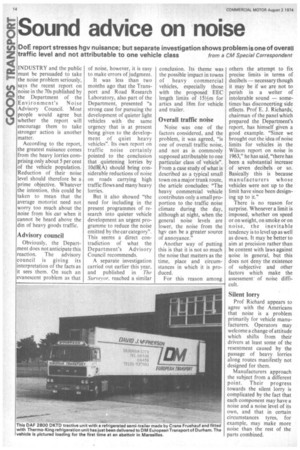Sound advice on noise
Page 16

If you've noticed an error in this article please click here to report it so we can fix it.
DoE report stresses hgv nuisance; but separate investigation shows problem is one of overall traffic level and not attributable to one vehicle class from a CM Special Correspondent INDUSTRY and the public must be persuaded to take the noise problem seriously, says the recent report on noise in the 70s published by the Department of the Environment's Noise Advisory Council. Most people would agree but whether the report will encourage them to take stronger action is another matter.
According to the report, the greatest nuisance comes from the heavy lorries comprising only about 5 per cent • of the vehicle population. Reduction of their noise level should therefore be a prime objective. Whatever the intention, this could be taken to mean that the average motorist need not worry too much about the noise from his car when it cannot be heard above the din of heavy goods traffic.
Advisory council
Obviously, the Department does not anticipate this reaction. The advisory council is giving its interpretation of the facts as it sees them. On such an evanescent problem as that of noise, however, it is easy to make errors of judgment.
It was less than two months ago that the Transport and Road Research Laboratory, also part of the Department, presented "a strong case for pursuing the development of quieter light vehicles with the same urgency that is at present being given to the development of quiet heavy vehicles". Its own report on traffic noise certainly pointed to the conclusion that ,quietening lorries by 10dB(A) should bring considerable reductions of noise on roads carrying high traffic flows and many heavy lorries.
But it also showed "the need for including in the present programmes of research into quieter vehicle development an urgent programme to reduce the noise emitted by the car category". This seems a direct contradiction of what the Department's Advisory Council recommends.
A separate investigation carried out earlier this year, and published in The Surveyor, reached a similar conclusion. Its theme was the possible impact in towns of heavy commercial vehicles, especially those with the proposed EEC length limits of 151/2m for artics and 18m for vehicle and trailer.
Overall traffic noise
Noise was one of the factors considered, and the problem, it was agreed, "is one of overall traffic noise, and not as is commonly supposed attributable to one particular class of vehicle". From a case study of what is described as a typical small town on a major trunk route, the article concludes: "The heavy commercial vehicle contributes only a small proportion to the traffic noise climate during the day, although at night, when the general noise levels are lower, the noise from the hgv can be a greater source of annoyance."
Another way of putting this is that it is not so much the noise that matters as the time, place and circumstances in which it is produced.
For this reason among others the attempt to fix precise limits in terms of decibels — necessary though it may be if we are not to perish in a welter of intolerable sound — sometimes. has disconcerting side effects. Prof E. J. Richards; chairman of the panel which prepared the Department's report, has himself given a good example. "Since we brought out the idea of noise limits for vehicles in the Wilson report on noise in 1963," he has said, "there has been a substantial increase of seven decibels or so. Basically this is because manufacturers whose vehicles were not up to the limit have since been designing up to it."
There is no reason for surprise. Whenever a limit is imposed, whether on speed or on weight, on smoke or on noise, the inevitable tendency is to level up as well as down. It may be better to aim at precision rather than be content with laws against noise in general, but this does not deny the existence of subjective and other factors which make the assessment' of noise difficult.
Silent lorry
Prof Richard appears to agree with the Americans that noise is a problem primarily for vehicle manufacturers. Operators may welcome a change of attitude which shifts from their drivers at least some of the resentment caused by the passage of heavy lorries along routes manifestly not designed for them.
Manufacturers approach the subject from a different point. Their progress towards the silent lorry is complicated by the fact that each component may have a noise and a noise level of its own, and that in certain circumstances tyres, for example, may make more noise than the rest of the parts combined.




























































































